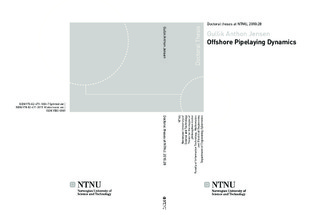| dc.description.abstract | This thesis considers three issues regarding modeling of oshore pipelaying dynamics. These are: (i) the formulation of an oshore pipeline installation operation as a control problem, (ii) the development and passivity analysis of a robotic pipe model for a submerged pipe string, suitable for real{time applications in closed{ loop control systems, and (iii) the development and validation of a nonlinear FEM model for simulation and control of the elastic pipeline dynamics, including FEM dynamics of a pipeline combined with vessel dynamics, for simulation and control of pipelay operations under dynamic positioning.
Pipeline installation is de ned as the operation of positioning a pipeline along a reference path on the seabed from a surface vessel. In control terms, this can be stated as a path{following control problem, where the pipe touchdown point tracks the reference path. However, the only controllers for the touchdown point are the pay{out of pipe into the water, and the motion of the surface vessel. Considering that the pipe is an elastic body, and that both the pipe and the vessel are subject to environmental loads, the control problem that must be considered is a dynamic target{tracking problem, where the surface vessel must track a moving target position on the surface in order to control the position of the touchdown point. A target{tracking controller may be implemented as a guidance system, by extending the dynamic positioning system that is common for pipelay vessels. An important component in the guidance system is the dynamic pipe model mapping touchdown and surface vessel position.
Motivated by robotics, a compact system formulation is derived for the suspended pipeline by considering it as a hyper{redundant manipulator with an arbitrary number of links. This model captures the main dynamics of the pipe, including its geometric con guration and top tension. The model is in the state{ space, and on a vectorial form using minimal coordinates. A passivity analysis establishing input{output passivity of the system is performed. This model is applicable in simulations where the main dynamics are required, and the available computation time is limited.
Static and dynamic analysis of pipelines during installation is characterized by a combination of geometrical nonlinearities and extreme exibilities of the system. A nonlinear PDE formulation for the pipeline is developed based on a three{ dimensional elastic beam model, taking into account the internal forces of longitudinal extension, shearing, twist and bending, as well as external loads from gravity, buoyancy, hydrodynamic drag, seabed interaction, and environmental loads. This highly exible system is then coupled to a dynamic model of the pipelay vessel. A passivity analysis establishing input{output passivity of these systems separately, and combined, is performed.
A nonlinear FEM model, based on exact kinematics, is derived to approximate the solution of the PDE pipe formulation. The weak formulation of the PDE is semi{discretized in the curve parameter into a nite dimensional space to obtain an explicit set of ordinary dierential equations. This semi{discretized model is solved by using standard integrators for time. The set of ordinary dierential equations is a convenient representation for simulation and control of pipelay operations under dynamic positioning. The model is successfully validated against the natural catenary and the commercial FEM code RIFLEX. The model has potentially numerous applications in dynamical analysis, in control system design and simulation, and in tools for training and decision support. | nb_NO |
